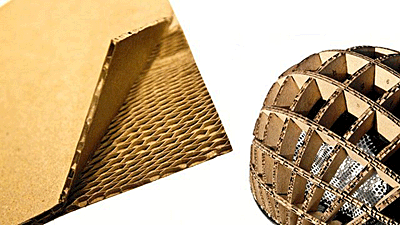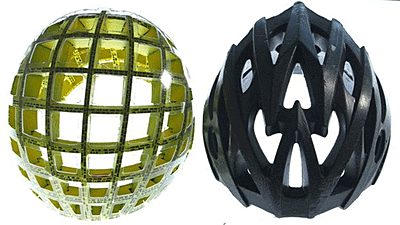Safer Bike Helmets Made of Paper
![]() Print this Article | Send to Colleague
Print this Article | Send to Colleague
 Anirudha Surabhi, who lives in London, U.K., recently had a severe biking accident. As Anna Lacey describes in an article for the BBC Health Check, Surabhi was riding his bike down a hill, wearing a helmet, when a man ahead of him suddenly opened his car door.
Anirudha Surabhi, who lives in London, U.K., recently had a severe biking accident. As Anna Lacey describes in an article for the BBC Health Check, Surabhi was riding his bike down a hill, wearing a helmet, when a man ahead of him suddenly opened his car door.
"I hit the door, did a couple of somersaults, and fell straight on my head. My helmet was completely cracked, completely unusable," Surabhi explains in the article. Luckily, he was able to walk away from the accident with only whiplash and a mild concussion.
But the sight of his mangled polystyrene helmet got the then design student thinking about new ways of protecting cyclists. The solution he eventually envisioned was to use intricately engineered paper (on left in photo below) instead of polystyrene (on the right). Although the idea of a paper helmet being safer than polystyrene at first seemed somewhat ludicrous, the approach is now "catching on" with many bike-lovers.

In Lacey’s article, Jolyon Carroll, a safety researcher at U.K.'s Transport Research Laboratory, told the BBC that "the danger with falling off your bike is that you subject your head to a dramatic change of speed in just a fraction of a second. When you hit the pavement, your hard skull will stop or decelerate quickly. However, being a relatively soft organ, your brain tends to keep going. If you imagine dropping a blancmange (a cake type of dessert made from gelatinous ingredients) onto a plate then you can see how bits at the back start compressing and piling up against other bits of brain at the front. It's this action that puts you at risk of injury—from breaking blood vessels to damaging brain tissue."
The basic idea behind cycle helmets is to create a mini crumple zone, somewhat like in a car, that absorbs some of the energy and gives the skull and brain more time to slow down before coming to a stop. Those extra few milliseconds can reduce the amount of compression in the brain and potentially make the difference between brain damage and a mild case of concussion.
While the main material used today in cycling helmets is polystyrene, Surabhi wasn’t convinced that it's the best choice for the job. Instead, he looked to the natural world for inspiration.
"The animal that stood out was the woodpecker," he said. "It pecks at about 10 times per second and every time it pecks it sustains the same amount of force as us crashing at 50 mph. It's the only bird in the world where the skull and the beak are completely disjointed, and there's a soft corrugated cartilage in the middle that absorbs all of the impact and stops it from getting a headache."
To mimic the woodpecker's crumple zone, Surabhi turned to a cheap and easily accessible source—paper. He engineered it into a double-layer of honeycomb that could then be cut and constructed into a functioning helmet (see photo below). What you end up with is tiny little airbags throughout the helmet," he said.

"So when you have a crash, these airbags go pop, pop, pop, pop, pop –and they go all the way to the bottom, without the helmet cracking. That's what absorbs the energy. "
The paper design has been tested to European standards, and the results are impressive when compared with a standard polystyrene helmet.
"If you crash at 15 mph in a normal helmet, your head will be subjected to around 220G (G-force), whereas the new design absorbs more of the impact and means you experience around 70G instead," Surabhi noted. To put that into context, international safety standards recognize that to avoid serious brain damage, a person must not be exposed to impact forces above 300G.
This means that while a polystyrene helmet helps avoid fatal or serious head injury, the paper helmet will give the head more time to slow down and potentially lower the risk of even less serious injuries like concussion.
Surabhi's paper helmet is already available in shops. He also has new ideas in the pipeline for his honeycomb design, including a flat-pack version suitable for cyclists using city bike hire schemes.


